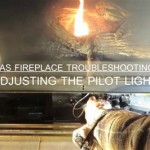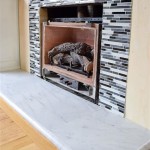Fireplace Refacing Ideas: Transforming Your Hearth into a Stunning Focal Point
The fireplace often serves as the heart of a home, providing warmth, ambiance, and a natural gathering place. Over time, however, its appearance may become outdated, worn, or simply no longer aligned with the homeowner's aesthetic preferences. Refacing a fireplace offers an opportunity to revitalize this central feature without the extensive demolition and reconstruction associated with a complete fireplace remodel. Refacing involves updating the visible surfaces of the existing fireplace structure, such as the surround and hearth, to dramatically alter its style and appearance. This can be a cost-effective and less disruptive way to bring new life to a living space.
This article explores various fireplace refacing ideas, providing insights into materials, styles, and considerations to help homeowners make informed decisions. Understanding the options available and the factors influencing the refacing process is crucial for achieving a successful and aesthetically pleasing result.
Exploring Material Options for Fireplace Refacing
Selecting the right materials is paramount in fireplace refacing. The chosen materials not only contribute to the overall aesthetic but also impact the durability, maintenance requirements, and safety of the finished fireplace. A wide array of materials are available, each with its own characteristics and advantages.
Brick: Brick remains a classic and versatile choice for fireplace refacing. Its inherent warmth and textural appeal create a timeless aesthetic suitable for various architectural styles. Brick offers numerous options in terms of color, size, and texture, allowing for customization to match the existing décor. Reclaimed brick, in particular, provides a rustic and characterful look. Brick is also a durable and fire-resistant material, making it a practical choice for fireplace surrounds.
Stone: Stone refacing offers a touch of natural elegance and sophistication. Natural stone, such as granite, marble, limestone, and slate, imparts unique textures and patterns, creating a focal point with inherent beauty. The variety of stone types allows for a wide range of aesthetic expressions, from the sleek and modern appeal of polished granite to the rustic charm of stacked fieldstone. Faux stone, made from manufactured materials, presents a cost-effective alternative that mimics the look and feel of natural stone. This allows homeowners to achieve the desired aesthetic without the higher price tag and weight considerations associated with natural stone.
Tile: Tile offers a versatile and customizable option for fireplace refacing. Ceramic and porcelain tiles are available in a vast array of colors, patterns, and sizes, providing endless design possibilities. From intricate mosaic patterns to large-format tiles that create a seamless look, tile can be tailored to suit any style. Tile is also relatively easy to clean and maintain, making it a practical choice for a high-traffic area. Glass tile adds a touch of contemporary elegance, reflecting light and creating a visually appealing effect. Metal tiles, such as stainless steel or copper, offer a sleek and modern aesthetic.
Wood: Wood refacing can bring warmth and rustic charm to a fireplace. Wood surrounds can be crafted from various types of wood, such as oak, maple, cherry, or pine, and finished with stain, paint, or varnish to achieve the desired look. Wood can be used to create intricate carvings, raised panels, or simple, clean lines. Reclaimed wood adds a unique character and a sense of history. When using wood for fireplace refacing, it is crucial to ensure that it is properly treated and installed to meet fire safety standards. Consider using a non-combustible material, such as concrete board, as a backing for the wood surround to provide an extra layer of protection.
Concrete: Concrete is gaining popularity as a modern and versatile material for fireplace refacing. Its industrial aesthetic and minimalist appeal make it a suitable choice for contemporary homes. Concrete can be cast in various shapes and sizes, allowing for creative design possibilities. Polished concrete offers a sleek and sophisticated look, while textured concrete provides a more rustic and tactile feel. Concrete can also be stained or colored to match the surrounding décor. Its durability and fire resistance make it a practical choice for fireplace surrounds.
Stylistic Approaches to Fireplace Refacing
Beyond material selection, the stylistic approach to fireplace refacing plays a crucial role in determining the overall aesthetic. The style should complement the existing décor of the home and reflect the homeowner's personal preferences. Whether it is a modern minimalist design or a traditional rustic look, the stylistic approach should be carefully considered.
Modern Minimalist: Emphasizes clean lines, simple shapes, and a neutral color palette. This style often incorporates materials like concrete, glass, and metal, creating a sleek and uncluttered look. A minimalist fireplace may feature a simple rectangular surround without ornate details or embellishments. The focus is on functionality and understated elegance.
Traditional: Characterized by classic designs, ornate details, and a warm color palette. This style often incorporates materials like brick, stone, and wood with elaborate carvings or moldings. A traditional fireplace may feature a mantelpiece adorned with decorative accents, such as corbels, pilasters, or a decorative fire screen. The emphasis is on creating a sense of timeless elegance and sophistication.
Rustic: Embraces natural textures, earthy tones, and a sense of warmth and comfort. This style often incorporates materials like reclaimed wood, stacked stone, and exposed brick, creating a cozy and inviting atmosphere. A rustic fireplace may feature a large stone hearth, a rough-hewn wood mantel, and a decorative fire grate. The emphasis is on creating a connection with nature and a sense of relaxed informality.
Contemporary: Blends modern and traditional elements, creating a balanced and stylish look. This style often incorporates materials like tile, glass, and metal with clean lines and geometric shapes. A contemporary fireplace may feature a sleek tile surround with a minimalist mantel or a glass-enclosed firebox. The emphasis is on creating a sophisticated and up-to-date aesthetic.
Eclectic: Combines various styles and materials, creating a unique and personalized look. This style allows for creative expression and the incorporation of personal touches. An eclectic fireplace may feature a mix of tile patterns, a vintage mantel, and a collection of decorative objects. The emphasis is on creating a space that reflects the homeowner's individual personality and tastes.
When selecting a stylistic approach, it is important to consider not only the existing décor of the home but also the overall architectural style. A modern minimalist fireplace may not be the best fit for a traditional Victorian home, while a rustic fireplace may feel out of place in a sleek contemporary apartment. Careful consideration of these factors will ensure that the refaced fireplace complements the surrounding space and enhances the overall aesthetic.
Key Considerations for a Successful Fireplace Refacing Project
Successfully refacing a fireplace requires careful planning and execution. Several key considerations must be addressed to ensure a smooth and satisfactory outcome.
Budget: Establishing a realistic budget is essential before embarking on a fireplace refacing project. The cost of refacing can vary significantly depending on the materials chosen, the complexity of the design, and the scope of the work. Obtain quotes from multiple contractors to compare prices and services. Factor in the cost of materials, labor, permits (if required), and any unforeseen expenses. Sticking to a budget will help avoid financial strain and ensure that the project remains feasible.
Structural Integrity: Before refacing a fireplace, it is crucial to assess its structural integrity. Inspect the existing fireplace structure for any signs of damage, such as cracks, crumbling mortar, or water damage. If structural issues are identified, they must be addressed before proceeding with the refacing project. Consult with a qualified professional to evaluate the structural integrity and recommend necessary repairs. Refacing a structurally unsound fireplace can be dangerous and may result in further damage.
Building Codes and Permits: Familiarize oneself with local building codes and permit requirements before starting a fireplace refacing project. Many jurisdictions require permits for fireplace modifications, especially if the project involves structural changes or alterations to the gas or electrical lines. Failing to obtain the necessary permits can result in fines, delays, and potential safety hazards. Contact the local building department to inquire about specific requirements and ensure compliance with all applicable regulations.
Professional Installation: While some homeowners may attempt to DIY fireplace refacing, professional installation is generally recommended, especially for complex projects or when working with materials like stone or tile. A qualified contractor has the expertise, experience, and tools necessary to ensure a proper and safe installation. They can also advise on design options, material selection, and potential challenges. Professional installation can save time, prevent costly mistakes, and ensure that the finished fireplace meets safety standards.
Fire Safety: Fire safety is paramount when refacing a fireplace. Ensure that all materials used are fire-resistant or non-combustible. Maintain proper clearances between the fireplace opening and combustible materials, such as wood framing or furniture. Install a functional fire screen to prevent sparks or embers from escaping the fireplace. Regularly inspect the chimney for creosote buildup and schedule professional chimney cleaning as needed. Following fire safety guidelines will help prevent fires and protect the home and its occupants.
Maintenance: Consider the long-term maintenance requirements of the chosen materials. Some materials, such as natural stone, may require periodic sealing or cleaning to maintain their appearance. Wood surrounds may need to be refinished or repainted over time. Tile and concrete are generally easy to clean and maintain. Understanding the maintenance requirements of the chosen materials will help ensure that the refaced fireplace remains in good condition for years to come.
By carefully considering these factors, homeowners can approach fireplace refacing projects with confidence and achieve a stunning transformation that enhances the beauty and functionality of their living space. A well-planned and executed refacing project can revitalize a fireplace, turning it into a focal point that adds value and enjoyment to the home.

15 Fabulous Fireplace Refacing Ideas Average But Inspired

30 Fireplace Remodel Ideas For Any Budget

10 Fireplace Makeover Ideas Before And After Regency

15 Fabulous Fireplace Refacing Ideas Average But Inspired

Cozy Fireplace Renovation Ideas Worthington Design Remodeling

Stone Fireplace Design And Remodel

5 Fireplace Makeover Ideas The Inspired Room

9 Fireplace Remodel Ideas For Any Budget Bassemiers

83 Fireplace Remodels Ideas Remodel Home

10 Fireplace Makeover Ideas Before And After Regency
Related Posts








